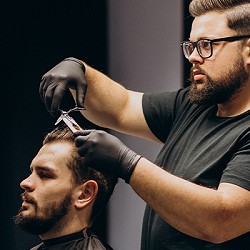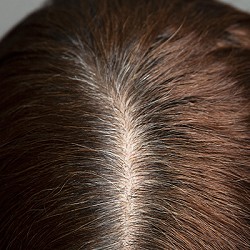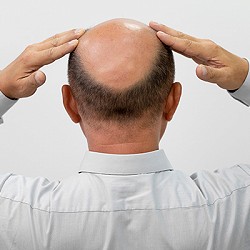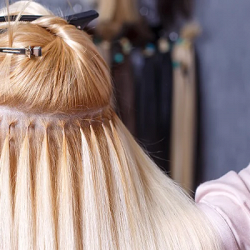
ADVANCED HAIR STUDIO
Losing Hair on Temples? Experts Explain Why
- 14 March 2024
- 4 min. read
In particular, when it comes to hair loss, the telltale indicators of ageing vary from person to person. For some, it manifests as hair loss at the crown of the head or the development of a bald spot in the back. In contrast, for others, it mostly manifests as hairline receding in the front, particularly when it is focused around the temples, where it creates a W-shaped hairline. Your temples, the area behind your eyes, and between your ear and forehead can experience hair loss. Many conditions might cause this hair loss. The sooner you consult a doctor, the higher your chances of reducing hair loss and even experiencing hair growth.
Reasons for Hair Loss
We must examine the causes of hair loss to comprehend thinning hair near the temples. Our experts say that there are three main causes of hair loss.
- Genetics The most frequent cause is genetics, specifically an androgenetic alopecia disorder, sometimes known as male-pattern hair loss. When Hair follicles in the concerned areas become susceptible to circulating androgens (male hormones), such as testosterone and dihydrotestosterone, it results in a gradual thinning of the Hair. Affected follicles gradually produce finer, shorter hairs until growth stops.
- Health Issues In addition to genetic factors, several medical problems might cause hair loss, such as:
- Autoimmune diseases like lupus and alopecia areata
- other drugs, such as chemotherapy and hormone supplements
- Infections with fungi and scalp ringworm
- Telogen effluvium, or hair loss brought on by serious or persistent illness
- Thyroid disorders
- Daily Habits/ Lifestyle Sometimes, a good, long look in the mirror can reveal the cause of hair loss, particularly in the area around the temples. Tight hairstyles like braids or ponytails can result in traction alopecia. This hair loss causes the hairline to regress due to pulling pressures on the Hair follicles. While the Hair around the temples may be affected, the entire hairline is more frequently affected. Trichotillomania is a disorder where people have the impulse to pluck off their Hair. Although it doesn’t only affect our head hair, that’s where you’ll notice it the most. Examine your nutrition and daily routines because iron and vitamin B12 deficiency can cause hair loss. Last but not least, the most evident cause of your hair loss may be as near as the equipment and products you use to style it, particularly harsh dyes, bleaches, and even straightening treatments, which can all damage the Hair and scalp and result in excessive loss.
- Pregnancy-related hormone alterations
- Stress-inducing hairstyles like cornrows or ponytails (traction alopecia)
- Adverse effects of specific drugs
- Vitamin D and B vitamin deficits brought on by smoking
- A New Haircut Obtaining a short, sharp haircut that sits close to the head and darkens or lightening your Hair, depending on what best complements your natural colour and style. It will decrease the contrast between long Hair and bald area.
- Micropigmentation A new process called scalp micropigmentation employs tiny needles to deposit pigment into the scalp to provide the look of fuller hair with a short haircut that, when done perfectly, is undetectable and natural-looking. Unfortunately there are very high instances now where people after performing this are again coming out in search of hair that grows and is able to give them length.
- Products for Camouflaging Various powders and foams are available to create the appearance of thicker Hair, but using them correctly requires skill.
- PRP Therapy PRP therapy has been demonstrated to be particularly helpful in the temporal area. PRP therapy helps promote growth for additional starved hair follicles. It offers nutrition for dormant hair follicles by injecting or microneedling platelet-rich plasma from the patient’s blood into the scalp region. It helps to stimulate hair growth. While PRP therapy has a chance to work, it can also be costly and take multiple sessions to provide observable results.
- Hair Restoration Surgery Hair restoration surgery includes removing hair follicles from the back side of the scalp and transplanting them, under local anaesthetic, to thinning or denuded areas. Hair restoration surgery is one of the most successful hair loss treatments for thinning Hair at the temples because hair follicles in the back of the scalp are not affected by male pattern hair loss and maintain this property even when moved to thin areas. Please research before committing because it’s also one of the fairly expensive, bit time-consuming, and irreversible options.
- Medication When used consistently, minoxidil can lessen the signs of hair loss by slowing down hair loss, but results could vary. With consistent use, some people can keep their Hair’s density while others only see a slowing of their hair thinning. The oral drug finasteride prevents the 5-alpha reductase enzyme from producing, resulting in a chemical reaction that can help stop hair loss. Although both are typically safe, it is important to consult a doctor before beginning either, particularly because finasteride may provide particular risks for users.
In layman’s words, most of us experience hair loss because our hormones are genetically predisposed. Each hair follicle gets smaller over time, the Hair gets finer and finer, and eventually, there is no more hair growth, leaving us with bald and thinning patches. Some people notice that this pattern is most pronounced around their temples.
Symptoms of Hair Loss on Temples
Even though people can naturally shed up to 100 hairs per day, thinning hair is frequently one of the early indicators of impending hair loss. As you brush or take a shower, you can find that there is more Hair coming out. Another sign of hair loss on temples is a receding hairline, which can reach the temples. A widow’s peak, the V-shaped hairline that is frequently seen in men but that can also be seen by women, might result from hair loss in your temples.
Why am I losing Hair at the Temple Area?

Various illnesses and habits can bring on hair loss in your temples. The most typical cause of hair loss is androgenetic alopecia. It is referred to as male-pattern baldness in men. Hair loss above the temples is frequently the first symptom of this inherited form of hair loss. Female-pattern baldness in women can cause hair to thin out and sometimes make the scalp visible, although it usually does not include the hairline receding seen in men.
Additional typical reasons for hair loss in the temples include:
Hair Loss Treatments
Quick Fix Treatments
If you have thinning hair around the temples, try these simple remedies to improve your appearance:Long-Term Hair Loss Treatment
A few hair loss treatments, ranging from little downtime to many months of commitment, may be up your alley if you’re serious about a receding hairline treatment. To name a few:How does AHS Treat Temples Hair Loss?
The wisest thing to do is not waste time if you decide to take action because better results can typically be obtained when the hair loss is at an earlier stage. At AHS studio, we believe in getting to the root cause of hair loss through an advanced hair check by our experts and suggest a hair loss treatment option most suitable for your hair loss issues.Conclusion
Due to genetic and behavioural reasons, hair loss in the temples can affect both men and women. A medical expert can direct you toward the right course of treatment and assist you in determining the conditions and reasons for your symptoms.All you need is to show up at the AHS studio nearest you, and we will help treat hair loss and get your hair and confidence back. So book your appointment today.
-
Rate this post:
- - 109votes
Our Google Reviews






Related Posts
August 26, 2024
Mastering the Craft: The Path to Professional...
India's beauty and wellness sector has grown significantly, creating opportunities for exceptional people to...
August 22, 2024
How is the Immune System Related to Hair Growth
The human body is an intricately integrated system operating in unison. The correlation between the immune system...
August 14, 2024
Do Wigs Cause Hair Loss - Busting the Myths
For both men and women, hair loss can be an unpleasant experience. It can impact our self-esteem and confidence,...
August 07, 2024
Reasons Why You Should Go for Permanent Hair...
Since hair extensions are an excellent way to increase your hair's length, volume, and colour, they have grown in...










